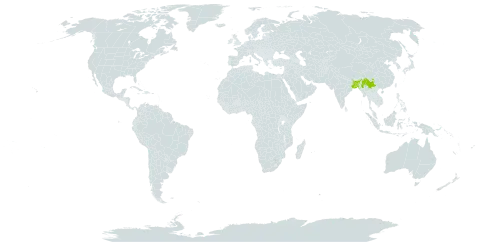Trees, small, 5-12 m tall; terminal buds densely appressed hairy (except stipules), twig tips, branchlets sparsely pubescent, hairs spreading. Stipules broadly triangular-ovate, minute, ca. 1 mm, papery, sparsely to densely appressed pubescent, ciliate, very early caducous, stipule scar sometimes increasing in size with age and becoming conspicuous; petiole 5-15 mm, pubescent, often sparsely so, hairs spreading, yellowish; leaf blade lanceolate or oblong-lanceolate, rarely oblong-elliptic, 9-21 × 4-8 cm, papery, abaxially pubescent throughout or sparsely pubescent only along midvein and lateral veins with spreading, yellowish or pale brown hairs, rarely subglabrous, adaxially glabrous or with a few hairs toward base, lateral veins 8-11 pairs, base rounded to cordate, often inequilateral, margin shallowly serrate, crenate, or subentire, apex acute or contracting rather gradually to an acumen to ca. 1.5 cm. Flowers few in axillary sessile glomerules, whitish, small. Pedicels 5-8 mm in flower, ca. 1 cm in fruit, articulate at base, pubescent, hairs spreading, yellowish; bracts ovate, 0.5-0.7 mm, papery, pubescent, ciliate. Sepals 5, ovate, 2-3 mm, outside pubescent except toward margin, hairs appressed to spreading and yellowish, inside glabrous or with few hairs, margin nearly glabrous. Disk lobes narrowly oblong, 1/2-3/4 as long as filament, densely hairy at apex, hairs drying white, long. Stamens 7 or 8; filaments pubescent, ca. 0.7 mm; anthers ovoid, ca. 0.5 mm, apex obtuse to apiculate, connective hairy. Ovary ovoid, 1-2 mm, practically glabrous; style short; ca. 0.5 mm, glabrous, stigma discoid, enlarged. Capsule 1-1.5 cm, obovoid to ellipsoid, fleshy, when dry outer surface blackish brown, densely and shallowly warty, at least in young fruit, pericarp with many ellipsoid inclusions, in dried material these black, shiny, conspicuous in pericarp cross-section. Seeds several, drying pale brown, ovoid, ca. 5 mm, surface smooth, enveloped by a thin, fleshy, partly fimbriate, pale yellowish aril. Fl. Jul-Aug, fr. Oct-Mar of next year.
